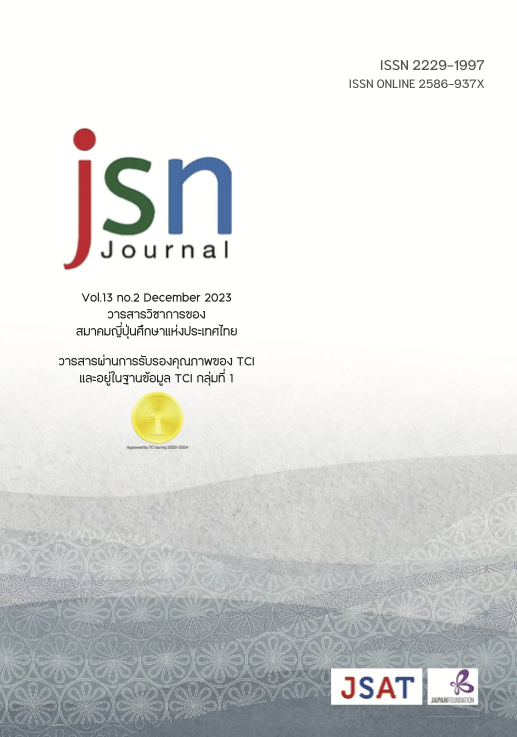Speech Acts on Japanese Posters to Raise Environmental Awareness
Main Article Content
Abstract
The objectives of this research are 1) to classify the speech acts that appear on Japanese posters aimed at raising awareness about the environment, based on Searle’s speech act theory (1969). 2) to study the occurrence of both direct and indirect speech acts on these posters. The dataset comprises Japanese utterances from 235 posters issued by Government Agencies across Japan's 47 prefectures. The posters were divided into 3 parts: headline, sub-headline, and body text, to facilitate an investigation into the types of speech acts present in each part.
The result showed that first, out of a total of 1986 utterances from 235 posters, the distribution of speech acts was representatives: 1181 utterances (59.47%), directives: 722 utterances (36.35%), expressives: 44 utterances (2.22%), declarations: 36 utterances (1.81%) and commissives: 3 utterances (0.15%). Representatives and directives were found in significant numbers across all parts of the posters. Second, a total of 1911 utterances (96.22%) were identified as direct speech acts, while 75 utterances (3.78%) were categorized as indirect speech acts. Among the indirect speech acts, directives were the most prevalent (42 utterances or 56%). Notably, commissives and declarations were not employed as part of indirect speech acts.
The findings of this research underscore the prevalence of representatives and directives, aligning with the posters' overarching objective of promoting greater environmental understanding and awareness. Consequently, representatives were used to convey factual information, while directives were employed to encourage readers to respond to the intentions of the message sender.
Article Details

This work is licensed under a Creative Commons Attribution-NonCommercial-NoDerivatives 4.0 International License.
ข้อความและข้อคิดเห็นต่างๆ ในบทความเป็นของผู้เขียนบทความนั้นๆ ไม่ใช่ความเห็นของกองบรรณาธิการหรือของวารสาร jsn Journal
References
กรัณฑรัตน์ หัสจำนงค์ และสุวัฒนา เลี่ยมประวัติ. (2562). การใช้วัจนกรรมในเพลงประจำสถาบันอุดมศึกษาของรัฐ. Veridian E-Journal Silpakorn University, 12(3), 119-130.
ณัฏฐ์ชุดา วิจิตรจามรี. (2556). การสื่อสารเพื่อการโน้มน้าวใจ. สำนักพิมพ์มหาวิทยาลัยเกษตรศาสตร์.
ณัฐวดี คมประมูล, จริญญา ธรรมโชโต, และ พัชลินจ์ จีนนุ่น. (2561). วัจนกรรมในการให้คำปรึกษาเรื่องความรักในคอลัมน์คนดังนั่งเขียนของดีเจพี่อ้อย. ผลงานวิจัยนำเสนอในการประชุมหาดใหญ่วิชาการระดับชาติและนานาชาติครั้งที่ 9, 119-130.
บุญโชค เขียวมา. (2550). การศึกษาวัจนกรรมบนป้ายหาเสียงของผู้สมัครรับเลือกตั้งผู้ว่าราชการกรุงเทพมหานครฯ ปี 2547. [สารนิพนธ์ปริญญามหาบัณฑิต สาขาวิชาภาษาศาสตร์การศึกษา ไม่ได้ตีพิมพ์]. มหาวิทยาลัยศรีนครินทรวิโรฒ.
เบญจมาภรณ์ ภิญโญพรพาณิชย์. (2554). คู่มือการปฏิบัติงานสื่อสารประชาสัมพันธ์กรมควบคุมโรค. http://odpc9.ddc.moph.go.th/DPC5/WorkManual1/p6-2.pdf
ปิลันธนา สงวนบุญญพงษ์. (2542). โปสเตอร์เพื่อการประชาสัมพันธ์โปรแกรมวิชานิเทศศาสตร์. สำนักพิมพ์มหาวิทยาลัยราชภัฏเพชรบูรณ์.
พัฒน์นรี นกชัยภูมิ, ศศิชณัฏฐ์ แย้มกลิ่น, ศโรชิน อาจหาญ และ ซอทอง บรรจงสวัสดิ์. (2562). การศึกษาวัจนกรรมในพาดหัวโฆษณาสินค้าประเภทอาหารในประเทศฝรั่งเศส. การประชุมวิชาการบัณฑิตศึกษาระดับชาติ สรรพศาสตร์ สรรพศิลป์ ประจำปี 2562, 496-507.
มนูญ ไชยสมบูรณ์. (2556). โปสเตอร์. https://www.gotoknow.org/posts/193335.
สุจริตลักษณ์ ดีผดุง. (2009). วัจนปฏิบัติศาสตร์เบื้องต้น. กรุงเทพมหานคร.
สำนักงานสภาพัฒนาการเศรษฐกิจและสังคมแห่งชาติ. (ม.ป.ป.). เกี่ยวกับ SDGs. https://sdgs.nesdc.go.th/
อรวรรณ ปิลันธน์โอวาท. (2526). วาทะสำคัญของไทยและการวิเคราะห์. สำนักพิมพ์จุฬาลงกรณ์มหาวิทยาลัย.
อัจจิมา นิตยประภา. (2558). กลวิธีการสื่อความหมายในบทโฆษณารณรงค์ทางโทรทัศน์เกี่ยวกับการบริโภคเครื่องดื่มแอลกอฮอล์ของสำนักงานกองทุนสนับสนุนการสร้างเสริมสุขภาพ (สสส.). [วิทยานิพนธ์ปริญญามหาบัณฑิต สาขาวิชาภาษาศาสตร์เพื่อการสื่อสาร ไม่ได้ตีพิมพ์]. มหาวิทยาลัยธรรมศาสตร์.
อัจฉราพร ใครบุตร และวิไลศักดิ์ กิ่งคำ. (2559). วัจนกรรมในบทเพลงปลุกใจให้รักชาติระหว่าง พ.ศ.2510–2550. วารสารมหาวิทยาลัยนครพนม, 6(1), 61-69.
Archer, D., & Aijmer K., Wichmann A. (2012). Pragmatics: an advanced resource book for students. Routledge.
Austin, J. L. (1962). How to do things with words. Oxford University Press.
Brown, P., & Levinson, S. C. (1987). Politeness: Some universals in language usage. Cambridge University Press.
Huang, Y. (2014). Pragmatics (second edition). Oxford University Press.
Searle, J. R. (1969). Speech Acts: An essay in the philosophy of language. Cambridge University Press.
Sutherland, S. (2016). A beginner’s guide to discourse analysis. London: Palgrave.
Yule, G. (1996). Pragmatics. Oxford University Press.
中園篤典 (2003).「機能文法としての発話行為の役割 : 発話行為の理論と展開」『人間環境学研究』1 (1/2), 117-135. 広島修道大学人間環境学会
山岡政紀 (2007).「発話行為と発話機能の比較」『日本語日本文学』17, 1-21.
山岡政紀・牧原功・小野正樹 (2010). 『コミュニケーションと配慮表現』東京:明治書院.
読売新聞 (2019). 「持続可能な開発目標 SDGs 未来都市に選定」2019年8月20日. https://database.yomiuri.co.jp/rekishikan/


